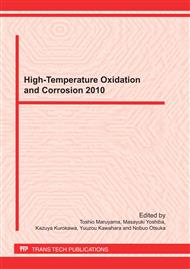p.242
p.248
p.254
p.260
p.266
p.272
p.278
p.284
p.290
High Temperature Corrosion Resistance of Siliconized Stainless Steel under Continuous Deposition of Salt
Abstract:
The surface alloying of Si into SUS304 austenitic stainless steel was carried out by a halide-activated pack-cementation method. By this treatment, the silicon diffusion layer containing about 13 at.% Si was formed. The high temperature corrosion resistance of this specimen was evaluated under the continuous deposition of salt. The result of the corrosion test showed that the oxidation mass gain of the siliconized stainless steel was lower than that of non-treated stainless steel. It was found from the observation of the cross-section of the specimen after the corrosion test that a thin scale was formed on the silicon diffusion layer and silicon oxide was formed as an inner layer of the scale. A mechanism of the oxidation suppression for the siliconized steel under the continuous deposition of salt was investigated by the oxidation test of pure silicon, iron, chromium or nickel powder mixed with equimolar NaCl-KCl. As a result, it was found that the high corrosion resistance of the siliconized steel was attributable to the fact that the silicon oxide formed on the silicon diffusion layer was inert to the chemical reaction with the NaCl-KCl salt.
Info:
Periodical:
Pages:
266-271
Citation:
Online since:
September 2011
Authors:
Price:
Сopyright:
© 2011 Trans Tech Publications Ltd. All Rights Reserved
Share:
Citation:


